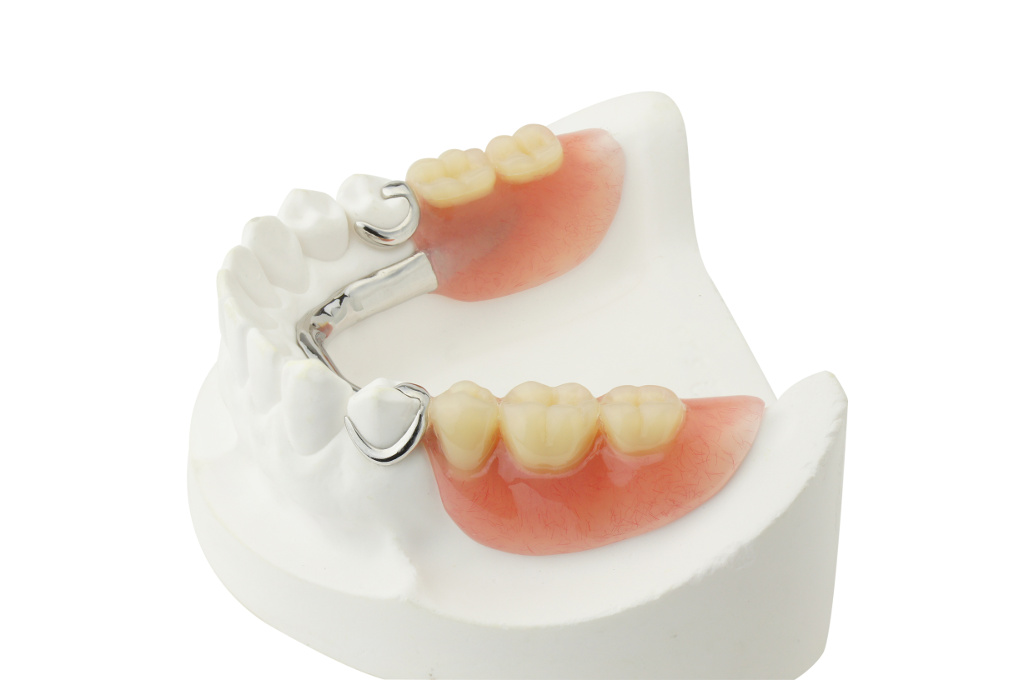Partial dentures

Partial prosthesis
- It is used to replace one or more teeth in a jaw (upper or lower). Missing teeth may or may not be adjacent.
- It is mainly used when several teeth are missing, as there are other solutions for replacing a single tooth, such as bridges.
- It rests on the gum and, with the help of clasps, on adjacent healthy teeth.
- It is more stable than a full denture because it rests on healthy natural teeth.
Metal
Made from a cobalt-chromium alloy, this partial denture can replace one or more missing teeth. It rests on the gums and remaining teeth, and is held in place by clasps on the natural teeth. It is used for both the upper and lower jaw. It features a gum-colored acrylic part and natural-looking artificial teeth.
Note: Before this prosthesis is fabricated, it’s important to have a thorough dental examination and cleaning to ensure that the teeth are free of decay and suitable to receive the custom-cast clasps.
The benefits
- Lightweight;
- Solid;
- Easy maintenance;
- Discreet and aesthetic;
- Little adjustment required;
- Does not interfere with tongue movement;
- Quick adaptation to this prosthesis;
- Metal conducts heat and cold;
- Does not damage the natural teeth on which it rests, and does not cause decay when rigorous hygiene is practised.
Disadvantages
- More expensive than acrylic prosthesis;
- At first, the teeth on which the clasps rest may be sensitive (temporary);
- The hooks may be visible in some cases.


Acrylic
Acrylic prostheses are also used to replace one or more missing teeth, but are less comfortable and less stable than metal prostheses. It is available with or without hook.
It is recommended as a transitional prosthesis for patients who expect to lose other natural teeth in the near future, and therefore require modification of their existing prosthesis or fabrication of a full denture. Acrylic partial dentures are also preferred by those who need treatment (e.g. of the gums) before they can wear a metal denture.
The benefits
- Economical choice;
- Made quickly.
Disadvantages
- Less comfortable and more fragile than metal prostheses;
- Thicker and covers more of the palate;
- Not recommended for the lower jaw;
- Long adaptation period;
- Must be checked and adjusted regularly;
- Less stable than a metal prosthesis.
Immediate
This prosthesis is inserted on the same day, immediately after the teeth to be replaced have been extracted, thus avoiding the need to go out in public with missing teeth. The immediate prosthesis is made from the impression of the original teeth, before they are extracted.
Note: If you have a new prosthesis made after the healing period, you can keep the immediate prosthesis as a spare, which is very practical in the event of breakage, loss or repair of your main prosthesis.
The benefits
- Since this prosthesis is designed while your natural teeth are still in your mouth, their shape, color and arrangement are easier to reproduce;
- Inserted immediately after extraction, it acts as a dressing, protecting tissues and limiting bleeding;
- Adapting to speaking with a prosthesis will be easier if you wear an immediate prosthesis than if you spend some time without teeth and prosthesis while waiting for a definitive prosthesis;
- The prosthesis also ensures that you don’t lose your ability to chew, and minimizes the facial distortion that can occur when teeth are removed;
Disadvantages
- The immediate prosthesis will require several adjustments (several visits to the denturist for temporary relines);
- Once the soft tissue has healed and the underlying bone has shrunk (3 to 6 months after extractions), the immediate prosthesis must be permanently relined or a new prosthesis fabricated.

